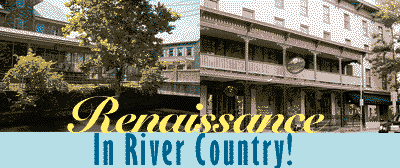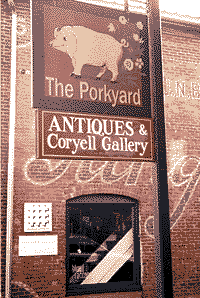Lambertville's resurgence began at the Lambertville Station (below, left) and continues at the recently completed Lambertville House (below, right). Buildings throughout town have been converted into prime antique, collectible and specialty shops.

The tree lined streets of Lambertville are made more captivating by a medley of Victorian buildings, pridefully decorated with flowers carefully planted in window boxes or perched atop an iron rail or brick wall. Small white picket fences front some houses, while others have decorative wrought iron gates. Porches sport white wicker chairs, and Victorian colored paints cover the brick, accentuating the trim. This is a charming town, indeed. But it wasn't always so....
A sleepy village which lost its industrial steam, the town was in slow decline until, in 1980, a man with a vision purchased the old Pennsylvania-Belvidere Railroad headquarters and train station depot. Dan Whitaker and his partners had been looking to "do a restaurant in Pennsylvania," he recalls. "I had seen the (train station) property eight years before, and had contacted Victoria Station, where I was working. They felt the demographics were all wrong, so they didn't take it. In hindsight, it was probably risky, but I felt New Hope had a lot of great restaurants, and this was just across the river." Today, the large windows of the Lambertville Station Restaurant are decorated with tiny white lights which reflect gracefully in the nearby Delaware River. But more importantly to Mr. Whitaker is the food. "The unique location and building will get people here once," he says, "but it's up to us to keep them coming back." And keep them coming back, they do. Specialties include "A seafood crepe which people love so much I couldn't take it off the menu if I wanted to. For dinner, Rack of Lamb is a favorite, but the offering of wild game year 'round has been a real draw." Next door the 45 room Inn at Lambertville Station, built about five years later, generally sells out for the weekends. (Guests should make reservations a month or two in advance.) An addition is being planned to double the number of rooms, and expand the conference/ banquet capacity to accommodate 300 people.
As the old Rail Station transformed into an elegant casual restaurant, other business owners started fixing-up their buildings, and new investors came to this quaint tiny city on the river. Artisans and up-scale antiques shops arrived, slowly at first, and then in a steady stream. According to Whitaker, "Once people looked at it (Lambertville), and saw it was a beautiful river town, they realized property values would only go up, so they began buying."

Today's Lambertville offers 45 Antique & Collectible shops, 16 Art Galleries, 25 restaurants, 9 B&Bs and Inns, 2 book stores, 2 flowers stores, 7 home accessory stores, 5 jewelry stores, 5 sports & recreation stores, a micro-brewing company and a unique lighting store along a bustling grid of charming streets about one mile square. Although the sidewalks are always busy, the general ambiance is one of leisure. Permission is granted to take in the sights at your own pace, and the town's popularity among those wishing to escape the daily work routine has not soared to levels of over-saturation.
Across the street from the Inn at the Station, another exquisite restoration has recently seen completion at the Lambertville House. Built in 1812, the historic inn was once a stagecoach stop serving U.S. Presidents, business leaders and dignitaries traveling between Philadelphia and New York. A significant investment revived its early 19th Century splendor and, with great attention to detail, transform it into an intimate country inn. The Renaissance continues.

Delightful fantasies beyond words! Gold, Platinum & Silver Jewelry, Wildlife Photos, Crystal, Lighthouses. Perfume Bottles, Santas, Witches Balls, Oil Lamps, Paperweights, Chimes, Art Glass, Wishing Stars. Also offering jewelry and watch repair

Artisanal cheeses, wood fired breads, 100% grass-fed beef, whey fed pork, and suckled veal, 100% grass-fed ice cream, pasta made with Emmer wheat and our own free-range eggs, and pesto made with our own basil! Bread and cheesemaking workshops are held on the working farm as well as weekend tours and occasional concerts.